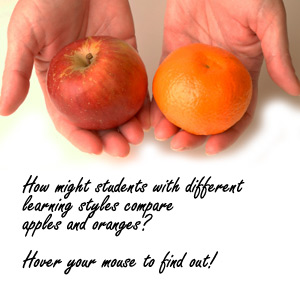Learning Styles

An essential part of creating differentiated instruction is to recognize how students cognitively process information. People learn through their senses and perceptions. Not only does perception provide much of what we remember, but it also anchors events in our memory to a particular place and time (Levine, 2000). We all have a different perception of the world, and this perception is largely driven by our individual learning styles.
These styles are:
- Auditory
- Visual
- Kinesthetic
- Tactual
Auditory learners are focused on speaking and listening. They enjoy discussions, lectures, conversing and anything that engages their sense of listening.
Visual learners are focused on what they see and must see things to learn them. These students learn best from graphic organizers, pictures, maps, videos, and demonstrations.
"Actions speak louder than words." For the kinesthetic learner this old adage is certainly true. Kinesthetic learners learn best by doing things. These learners are motivated by lessons that enable them to actively participate and use their large motor skills.
Tactual learners learn through their emotional and tactile senses. They are aware of the subtle emotional signals that others send. They are often adept at using their hands and benefit from touching things to get to know them better. These are the true hands-on learners.
While almost everyone uses all the senses in learning, most people learn best through a particular sensory/perceptual channel—kinesthetic, tactual, auditory, and/or visual (Gregory, 2005; Sprenger, 2005). Their learning style, or modality, is the channel through which they receive and retain information best (Gregory, 2005). In every classroom there is likely to be a mixture of preferences—students who are kinesthetic learners, tactual learners, auditory learners, and visual learners (Haggart, 2003). Sprenger (2005) suggests teachers can most readily differentiate instruction by considering students’ individual learning styles and strengths. By attending to students’ learning styles and differentiating instruction, teachers move toward personalizing instruction.
Earlier we discussed how a teacher can model thinking to help students develop their metacognitive skills. Problems can arise when the teacher thinks in a different style than a student. By understanding the different types of learning styles, you can model how to think in each style. For instance, if you were teaching your students to compare apples to oranges, you could describe each fruit, ask students to picture them in their mind, and ask students to remember what they feel like. In this way you would be appealing to the auditory, visual, and tactual learners in the class.
In the next module we will return to the subject of learning styles and how this relates to selecting materials and resources that align to your students' needs.
